26 Week marathon Training Plan + Free training schedule
Hey all of you beginner or repeat marathoners - 26 weeks to train to run a full marathon is within your reach!
Really and truly this is a great length of time to allow for that perfect balance between physically and mentally preparing while progressing injury-free.
My 26 week plan has been designed to progress gradually to minimize risk of injury, avoid burnout with the realistic preparation time, and prevent being overwhelmed. 26 weeks allows for time for your body to adapt to the demands of running long distances.
Keep reading to see the gist of what will transpire in the 26 weeks of training plus some insight, guidelines and tips to get you to that finish line in roughly 6 months!
Who Is This Plan Good For?
1. Beginner Runners Who Are Somewhat Fit
If you are already generally fit, you can aim to run this long distance having 26 weeks to prepare.
Do you already engage in physical activities such as cycling, swimming or other exercise forms that have built your cardiovascular fitness and muscular strength?
Already having some fitness will be helpful with the gradual build-up in intensity and distance that goes with this plan.
If you’re just not sure, check out this post that will help determine if you’re ready to run a marathon.
It includes a useful link for figuring out if your health is up to par for the challenges of this distance. It is also helpful in clarifying whether you need to seek professional advice to make doubly sure.
With marathon races being quite demanding, defining your goals when determining the length of time to give for overall preparation will also be useful in figuring out your readiness. For example, as a beginner, hoping to run having a certain time goal is probably not realistic. On the flip side, if you just want to cross the finish line, more than likely you'll be just fine.
After considering your current fitness level and your goals, if you feel you need to first build a little more of a foundation, no shame in that!
My “Running for Beginners Who Want to Race or Just Gain Fitness” post will provide valuable insight as will my post “How to Train for a Marathon as a Beginner - A Step by Step Guide to Running a Marathon”.
Looking for a longer training plan?
My 32 Week Beginner Marathon Training Plan might be right up your alley if you find you need just a little more training time. -Or, to really allow for building a base as well as throw in some time for life’s surprises, my 52 week plan should fit the bill!

2. Intermediate Runners and Advanced
This length of time is great for those who already have some running experience.
If you are a regular runner, having run before, you are already set up to train in 26 weeks fairly effortlessly - well…, you know…, as effortlessly as can be when training to run 26.2 miles. Admittedly, it’s still hard work.
Having this slightly longer training period will be helpful in that mileage will be increased safely while improving your endurance and pace.

3. Those who are coming off an injury
If you’re a veteran runner who needs to ease back into a training program to minimize the potential for further damage or stress, this program allows you to do just that by going at an easy pace and then following the gradual progression of the plan.

4. Those who just want or need a little more time to train than the average 16 to 20 weeks.
Need I say more?
{This training plan comes in both miles and kilometers!}
Free Version
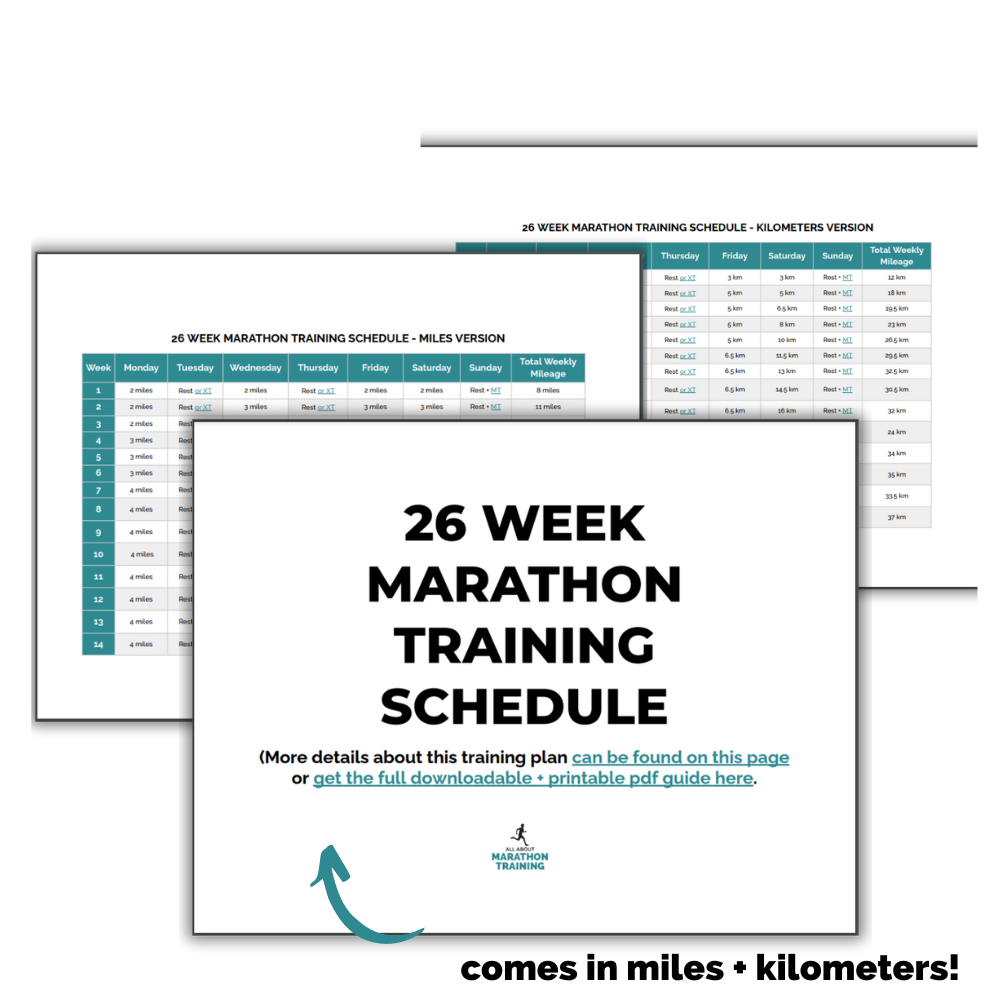
Paid version
Get the full 26 Week Marathon Training Plan + Guide here!
- the full training guide + breakdown,
- the training plan in miles & kilometers
- 20+ printable trackers and tools to enhance your performance! 👇
So What Can I Expect With This 26 week marathon training Plan?
Your 26 Week marathon Training Plan Components
The beauty of having 26 weeks is that training shouldn’t get overwhelming .
Each week, my 26-week plan consists of:
- 2 to 3 easy runs
- Long runs that start with a short distance and build up by a mile or two each week
- 1 day of recommended cross training
- 2 to 3 days of rest
- About a fourth of the way into the program you’ll start 1 day of hill training. This will later be replaced by interval workout training.
- Recommended mindset training (More on this below.)
Let's break these components down...
Easy Runs
The easy runs scheduled are to build endurance and increase stamina to set you up for your weekly long runs. The stress on your body is minimal while your durability is improving.
You’ll see 3 days scheduled with these shorter distance runs ranging from 2 to 4 miles. Easy-peasy, right?
Enjoy these easy runs and plan on pushing yourself more on the longer distance runs.

Long Runs
Your long runs are essential for building stamina to have success on marathon day. (To learn more about including this essential long run in your training program, this guide about long distance running will give you your fill.)
The long runs in this plan build at about 1 mile per week and are scheduled for Saturdays.
Here’s some good news: If Saturdays just don’t work for you to incorporate a long run, you can change your long run day to Sundays. More on making adjustments below…
This slow progression of the long runs will really keep those injuries at bay and your motivation high.
Toward the end of the program, you’ll run 20 miles as your longest training run. In fact, you’ll encounter 2 of the 20 mile preparation runs.
This will ensure you are ready for the marathon challenges!
Don’t let these long runs scare you. Remember, you’re building up to them by just one mile each week.
Also, the plan throws in several “recovery weeks'' in which you don’t increase your mileage but instead a much shorter distance is scheduled. This allows your body to repair muscles and tissues imposed from the strenuous demands of training.
You’ll find these recovery weeks at weeks 10, 16, 21 and, as you wind down in preparation for the marathon - weeks 23 and 25.
In fact, week 25 is really your taper week. -Meaning that the weekly mileage is reduced, allowing your body to recover and rest before the big day.
Studies have shown that this reduction in mileage results in peak performance come race day.
To quickly get your recovery underway on these scheduled weeks, this Long Distance Running Recovery Plan provides great guidance for what to do to ensure optimal recuperation.
And here's a 24 Hour Post Long Run Recovery Timeline to help you bounce back asap,
Now, previous marathon runners who are trying to meet or break a personal record goal, you can alter this plan and work up to a long run of 22 to 23 miles.
I wrote on how far your marathon training longest run should be on this page if you are trying to find your sweet spot.
Again though, if this is your first marathon, running with a time goal is not recommended.
And you also don’t need to even think about your long run pace - just run at a fairly moderate pace that will get you through the miles!

Cross Training
Working various muscle groups is never a bad thing and that’s where cross training comes in.
On this 26 week plan, while cross training is not absolutely required, it is encouraged. -But - I want to add that if the running part is sufficient for you, don’t feel guilty about not cross training. The running part is what this is all about, remember?
Cross training continues to build endurance with the benefit of increasing overall strength. Muscles that have been strengthened are another way of injury prevention during the bulk of your training.
Think swimming, rowing, cycling and strength training to name a few and try to incorporate this into your regiment one to two times each week.
Be aware that there are some sports that should be avoided when cross training. More info on these activities plus general cross training guidance for marathoners is included in this post.

Rest Days and Mental Training
As important as training days, are rest days - that’s why there’s 3 rest days included each week! Rest days allow your muscles to adapt and repair and actually even grow stronger and more resilient.
These scheduled rest days don’t mean you can’t be somewhat active. Use these days for some light stretching and, depending on how you feel, some cross training activities.
However, make sure to listen to your body. If your body is overly tired, you just might need to completely take the day off.
Another benefit of incorporating rest days is the mental break they provide. Mental damage can be just as debilitating as physical damage. Utilizing rest days for recuperation allows you to recharge and renew your desire to run.
Speaking of the mental aspect - rest days are great days to get some mental training in. Many runners find the mental aspects of long distance running much harder than the physical so building resilience is a must!
Really, all marathon training programs should encourage some mental training. Those of you who have run before realize how important it is to get that mind under control. Negative thoughts can really sabotage your efforts and wreck havoc throughout training and on marathon day.
Take some time to practice employing some techniques that you can utilize when the going gets rough. My 20 Week Mindset Training Plan for Marathoners is a structured program to prepare you for the 26.2 mile distance so be sure to check this course out.

Hill and Interval Training
Yes, this training plan includes some quality workouts - namely hill training and interval training. Both of these types of workouts have many benefits making them very worthwhile to incorporate into your marathon training regimen.
So Just What are the Benefits of Hill and Interval Training?
- Leg strength is improved with hill training which improves overall running economy. Cardiovascular efficiency is also increased allowing runners to approach varied terrains with less fatigue and greater ease.
- With interval training, speed, aerobic capacity and stamina are all boosted by alternating high-intensity workouts with periods of recovery. This aids in being able to sustain faster paces over longer distances.
- Both these training practices reinforce muscle function, improve stride workings and increase lactate threshold, and empower you with both physical and mental resilience that will serve well on race day.
So embrace these once a week sessions that start at week 8. -And no worries - they too increase gradually in intensity making them very easy to adjust to.
Free Version

Paid version
Get the full 26 Week Marathon Training Plan + Guide here!
- the full training guide + breakdown,
- the training plan in miles & kilometers
- 20+ printable trackers and tools to enhance your performance! 👇

Now For the Overall Breakdown of What is Done When Throughout the 26-Week Training Plan…
Weeks 1 - 7 Base Building
The focus during this phase is on easy runs that build up to a steady weekly mileage.
Your weekly long run begins with a 2 miler and gradually increases by a mile to end this phase running 8 miles.
Depending on the level you’re starting at, cross training can be incorporated right from the get-go to supplement and enhance your overall fitness. Ideally it should be continued throughout the program although if your body is screaming at you, take a break.
Starting my mindset training program (that was mentioned above) early on will give you ample time to learn the tips and tricks.
Weeks 8 - 16 Endurance Building
Hill repeats start this week and gradually increase in quantity week by week.
Your long runs also continue gradually increasing; however, when you reach week 16, you’ll have a recovery week to alleviate the stress and strain placed on muscles and tissues.

Weeks 17 - 24 Peak Training
Hill repeats are replaced by interval training when you hit week 17.
Long runs remain a key component with the longest run reaching almost the marathon distance - 20 miles.
Week 21 and 23 are other recovery weeks.

Weeks 25 and 26 Tapering and the Marathon!
Week 25 will have you cutting back on your training to allow your body to recover and be race-ready. You’re almost there!
This is also the period you should really start your carbo loading.
For the rookie runners out there, carbo loading is a popular method of filling up on foods that are high in carbs.
With carbs being the main nutrient that keeps you running on and on, it is essential to make sure your body has maximum stores. “Carb Loading - The Load Down On It” will help you understand more.
-And here is a 3 day menu of easy carb meals.
-And then it’s marathon week! With the reduction of weekly miles during these last two weeks, you should be fresh and energized when you head to the start line!
A look at the training plan
Here is a quick look at the first 14 weeks of the 26 week training plan in miles:
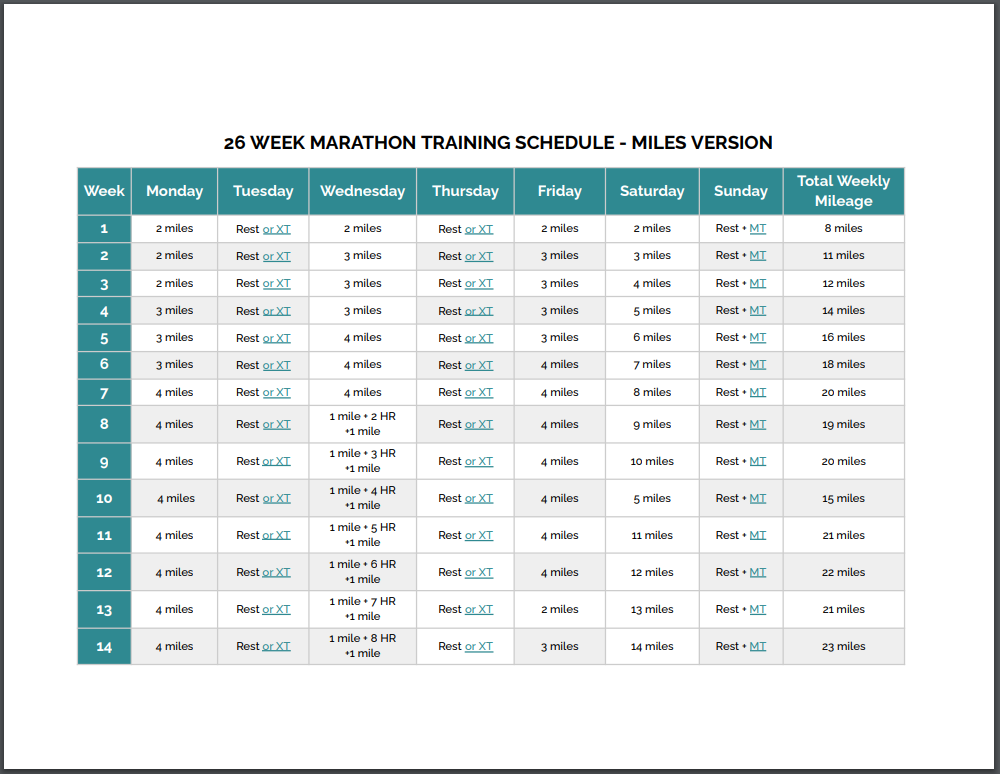
Here is a look at the first 14 weeks of the 26 week marathon training plan in kilometers:
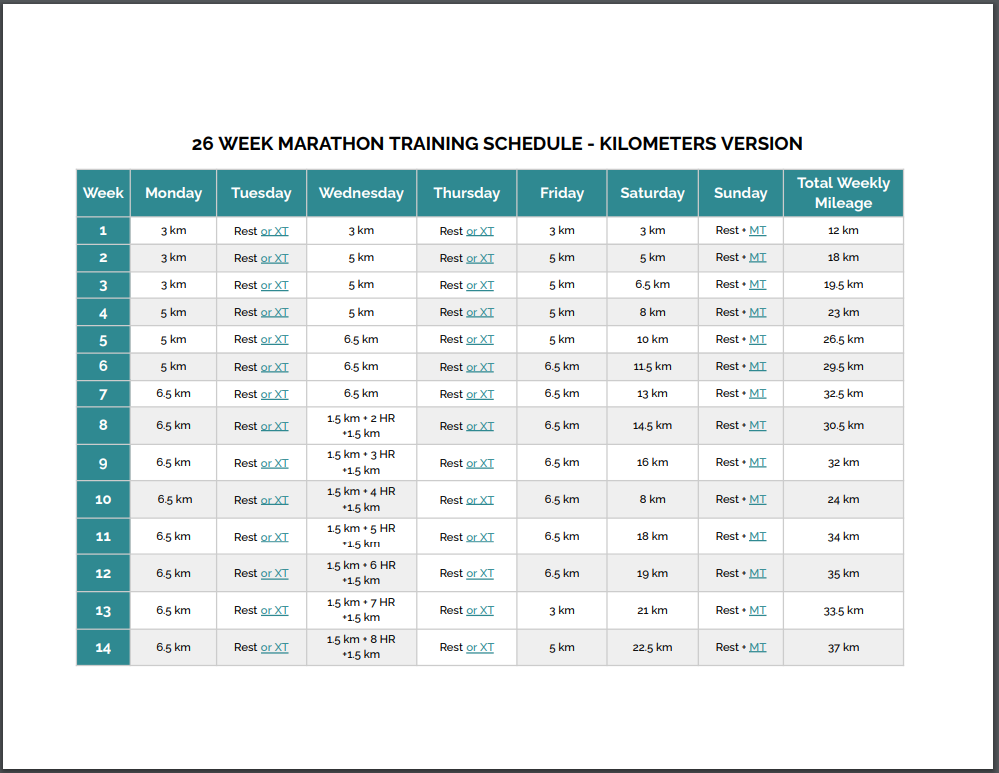
Are you ready to get started today? Which version do you want?
Free Version

Paid version
Get the full 26 Week Marathon Training Plan + Guide here!
- the full training guide + breakdown,
- the training plan in miles & kilometers
- 20+ printable trackers and tools to enhance your performance! 👇
Tweaking The Plan To Make It Work For YOU
First of all, although you want to follow the plan as best as possible, it is okay to deviate when necessary.
Don’t get so caught up in having to follow your running schedule to a tee that it ends up derailing you.
Like When?
Definitely when you’re feeling exhausted.
Over pushing yourself has the potential to hurt rather than help. Being relentless is not always a good idea.
If you have to take off a day or two or even a week off when a run is scheduled, then that’s what you have to do.
If it’s just a day, see if you can pick up the miles on another day. Or, maybe you’ll have to completely eliminate the run.
Just be honest with yourself. We can easily convince ourselves we need more time away and then before you know it, our plans are out with the trash.

Definitely when you have a minor injury.
Lighten up for a few days. Of course, some injuries require medical advice. How to know? Check out this Running Injuries post.
-And of course, major injuries are a whole other level and could cause you to put your marathon plan on hold.

Like when you know your upcoming week is going to be crazy.
Come up with an alternate plan to fit in most of your runs and workouts. Even if you have to cut back a mile or two during a run, it’s better than totally skipping.
A good rule of thumb is to strive to carve out time for your key runs like your long runs and, if necessary, eliminate the easy ones. I know, not what you want to hear, right?

Like when you’re on a totally different life schedule that doesn’t mesh with the plan.
If your schedule really doesn’t match with the training program, switch the days up so the days do work for you but make sure to maintain the pattern of the program. i.e. Easy run, rest, easy run, rest, easy run, long run, rest.
Ensuring Success
As runners get going with their training plan, they sometimes feel like they’ve maybe taken on more than they can handle.
Admittedly training for this distance isn’t for the faint of heart but don’t give up!
Instead try the following...
Run/Walk A Marathon
The run/walk method is a great option to incorporate into your training program.
So why run/walk? Maybe
- you are trying to reduce injury
- you are coming off of a recent injury or are trying to alleviate soreness
- you are discouraged by running the longer distances and need a little relief
- you are struggling to run consistently
- it will serve to motivate you
Whatever the reason, it doesn’t matter. It’s fine to incorporate some walking into your training.
To supplement this method in your training you want to find what run/walk ratio works best for you. This “Run Walking: Your Ultimate Guide” post is a worthy read as it explains this method in depth.

Employ Those Mental Tactics
Visualize your running success, pick a motivational mantra and/or a phrase to utilize during those tough runs, believe in yourself!
Really make an effort to learn those tactics I mention in my mindset training course.
Make Sure You’re Not Over (or Under) Doing Your Training
Sometimes our enthusiasm can come back to bite us. We deviate from our plan and do more than what is necessary. This can set us up for burn-out.
-Or, we feel we need a break and cut back unnecessarily. (Yes, sometimes due to an injury or chronic fatigue we might need to give our body a break. Again, just be honest with yourself when you want to rest more than what’s necessary.)
To be ready for our marathon, it’s best to stick with the consistency of your training plan. While it’s okay to shift the days of the program to match your schedule, do aim to keep the distances stated in your plan and the overall set up - easy run, rest, easy run, rest, long run…
With that said, having to drift a little isn’t going to thwart your plans. It’s when you regularly run more than what’s expected or regularly cut way back that you could set yourself up for challenges.
So trust the program and stick with it as much as possible!

Have a Regular Running Routine
As mentioned above, it’s okay to switch the days to fit your schedule as long as you stick to the pattern of what falls when.
Have Accountability and Support
Sharing your running fun and experiences with another runner or even a non-runner who is your biggest fan, goes a long way in keeping you enthused and motivated.
As does having a partner to actually join you on your runs - or even a whole group of runners.
Training groups in which you run with others, has so many benefits:
- You are held accountable to make sure your run happens
- Your runs can be more challenging by pushing yourself to keep pace
- Instills confidence in your running ability
- Provides a diversion - My favorite reason
- Keeps you motivated
- Increases your self-expectations
- Makes Running Fun!

Stay Motivated
How?
- Keep Running Records - Track your progress
- Watch a marathon movie
- Have marathon motivation know-how
- Read these 8 Running Motivation Tips and here’s more
- Read an inspiring running book
- Make time to laugh with these funny running spectator signs and these funny jokes

Free Version

Paid version
Get the full 26 Week Marathon Training Plan + Guide here!
- the full training guide + breakdown,
- the training plan in miles & kilometers
- 20+ printable trackers and tools to enhance your performance! 👇
You’re Not Done Yet - Another Key Component - A Word on Nutrition and Hydration
Proper hydration and nutrition are vital for training for a marathon. Have a plan for a balanced diet that is rich in carbohydrates, proteins and healthy fats. These three essentials fuel your runs and help with recovery.
- Carbohydrates provide necessary energy. Think whole grains, vegetables and fruit.
- Proteins are essential for muscle repair. Proteins include lean meats, eggs, fish and legumes.
- Healthy fats aid overall good health and include nuts, seeds, avocados and olive oil.
My “Marathon Nutrition: Your Guide to Eating Well” post is a great read to get you started on the right foot. (And here’s a post on nutrition mistakes to avoid when training and one to help you control your sugar intake!) To really have a solid nutrition action plan that eliminates all of the questions, try my Eat Like a Marathoner Nutrition Course!
Equally important is hydration. Make a conscious effort to regularly drink water throughout the day. No matter what distance you’re running, these hydration running tips will help prevent dehydration before you head out to run or while you’re out on a run.

Now You’re Done (Almost)
Having 26 weeks to train is really a great length of time to prepare at a very decent moderate pace.
Just follow the plan, prepare mentally, eat well and, tada! The success on your marathon day will fill you with joy - and enthusiasm to train for another!
Free Version

Paid version
Get the full 26 Week Marathon Training Plan + Guide here!
- the full training guide + breakdown,
- the training plan in miles & kilometers
- 20+ printable trackers and tools to enhance your performance! 👇
Related Pages:
👋Sign up to receive the free printable strength exercises for runners: 👇
 |
As featured on:



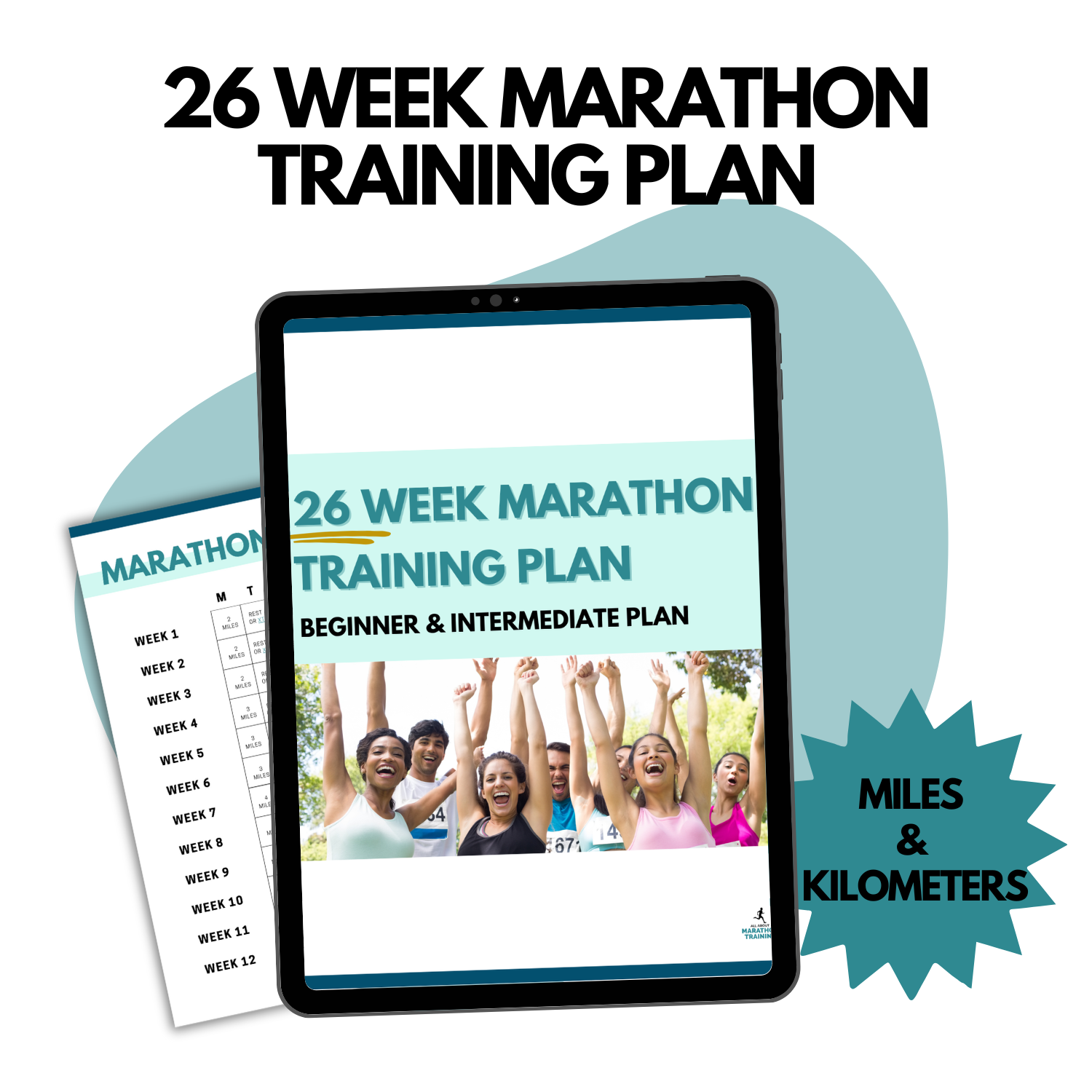






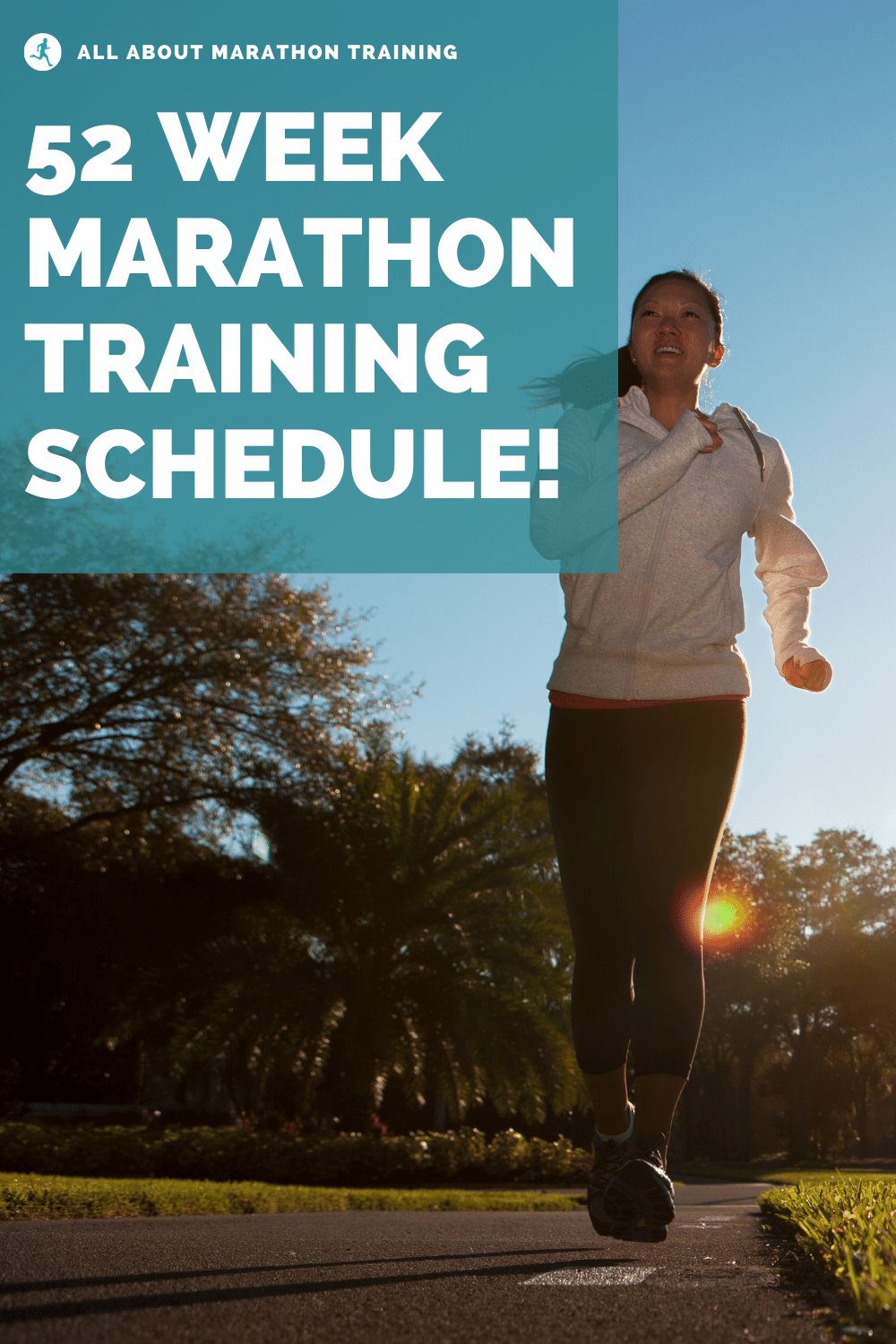

New! Comments
Have your say about what you just read! Leave me a comment in the box below.